What is the difference between millet and wheat and how to use them in cooking
Millet and wheat are two words derived from the ancient Slavic verb “pykhati”, meaning “to grind”. Our ancestors processed grains in mortars, using crushers to remove the husks. According to another version, both words come from the Polish “pseno”. Despite the same root, “millet” and “wheat” differ in meaning.
Let's take a closer look at how the two grains differ and which one is healthier.
Description of millet and wheat
Phonetically similar names designate different types of cereals, which have different appearance and nutritional composition and are used in cooking in different ways.
Definition of millet
Millet is a cereal grain that is obtained by processing seeds cultivated varieties millet (Panicum). Millet grains have a round or oval shape, yellow color, the size of the raw grains in diameter is from 1 to 2 mm.
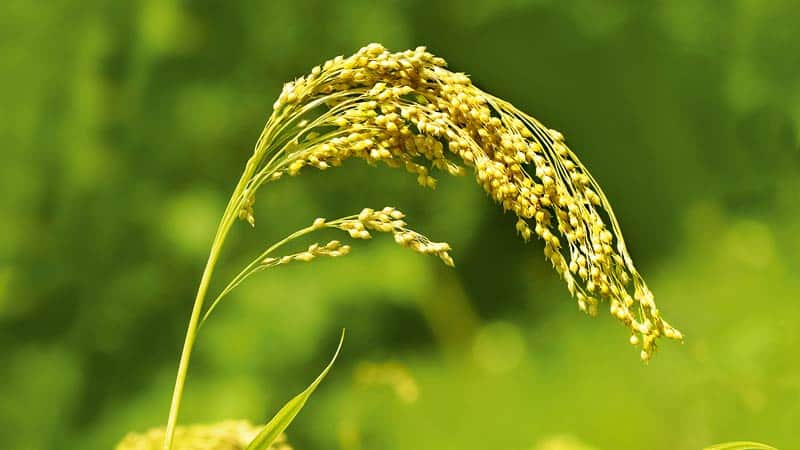
Pshenka used for making porridges, included in soups (ear, kulesh). Millet flour is used in cooking for baking bread, pies and other baked goods.
Depending on the quality of processing of millet grains, There are several types of millet cereals:
- Millet-dranets. The cereal is of low quality, millet grains are cleaned only from the rough shell.
- Millet. The cereal is of high quality; the grains, after removing the coarse shells, are ground, removing the aleurone layer.
- Crushed millet. The cereal consists of crushed grains, looks similar to wholemeal flour, and is used to make whole grain bread.
- Millet flakes. The cereal consists of polished millet that has undergone heat treatment with live steam.
Millet - a genus of herbaceous cereal plants growing in temperate latitudes Eurasia and America and northern Africa. The inflorescence of millet is a panicle, the fruit is a free grain.
Reference. Millet is a gluten-free grain, so millet can be consumed by people with gluten intolerance.
Definition of wheat
Wheat is a genus of herbaceous cereal plants., it is one of the most sought after crops all over the world. The genus Wheat has 20 species, including up to a dozen varieties. The inflorescence of wheat is a complex spike, the fruit is a free grain.

Flour is made from wheat, which is used for confectionery purposes, in the production of bread and pasta. In the spirits and beer industries, wheat is used along with barley and corn.
Four types of cereals are produced from wheat grains:
- Wheat groats – crushed polished grain.
- Semolina – purified finely ground grains with a particle diameter of 0.25-0.75 mm.
- Couscous – granulated semolina.
- Bulgur – whole peeled and polished wheat grains, thermally treated with steam.
Wheat cereals are used in cooking for cooking side dishes, desserts, soups and baby food dishes.
Comparative characteristics of millet and wheat
Millet and wheat grains differ not only in appearance, but also in chemical composition and nutritional value. These characteristics determine the difference in the use of cereals. Let's take a closer look at the difference between millet and wheat.
External differences
Millet They call ready-made cereals, and wheat refers to unprocessed grains. Bulgur cereals are most similar to millet in terms of processing, so it is rational to compare these types of cereals.
| External sign | Millet | Bulgur |
| Shape of grains | Round or slightly oval | Elongated oval with a characteristic longitudinal groove |
| Color | Yellow | Light golden |
| Whole grain size | 1-2 mm | 5-7 mm long and 1-3 mm wide |
| The taste of boiled cereals | Powdery, specific, may have a bitter aftertaste | Specific with a nutty flavor and creamy notes |
| The smell of cereal | Specific, with notes of cut grass | Reminds me of the smell of hazelnuts |
High-quality cereals do not have any foreign odors (mold, musty smell of rotting), there is no sourness or unpleasant aftertaste in the taste.

Differences in chemical composition and nutritional value
The properties of cereals and their benefits to the body are determined by their chemical composition. Let's determine what kind of cereal - millet or bulgur - healthier.
| Component of cereal composition | Contents of 100 g of raw millet | Contents in 100 g of raw bulgur |
| Water | 14 g | 9 g |
| Carbohydrates | 66.5 g | 57.57 g |
| Squirrels | 11.5 g | 12.29 g |
| Fats | 3.3 g | 1.33 g |
| Alimentary fiber | 3.6 g | 18.3 g |
| Vitamin A (carotenoids and other provitamins) | 22 mcg | 5 mcg plus 220 mcg lutein and zeaxanthin |
| Vitamin E | 0.3 mg | 0.06 mg |
| Vitamin K | — | 1.9 mcg |
| Vitamin B1 | 0.42 mg | 0.23 mg |
| Vitamin B2 | 0.04 mg | 0.12 mg |
| Vitamin B5 | — | 1.04 mg |
| Vitamin B6 | 0.52 mg | 0.34 mg |
| Vitamin B9 | 40 mcg | 27 mcg |
| Vitamin PP | 6.2 mg | 13.39 mg |
| Kholin | — | 28.1 mg |
| Potassium | 211 mg | 410 mg |
| Calcium | 27 mg | 35 mg |
| Magnesium | 83 mg | 164 mg |
| Sodium | 10 mg | 17 mg |
| Sulfur | 77 mg | — |
| Phosphorus | 233 mg | 300 mg |
| Chlorine | 24 mg | — |
| Iron | 2.7 mg | 2.46 mg |
| Iodine | 4.5 mcg | — |
| Cobalt | 8.3 mcg | — |
| Manganese | 0.93 mg | 3.05 mg |
| Copper | 0.37 mg | 0.34 mg |
| Molybdenum | 18.5 mcg | — |
| Selenium | — | 2.3 mcg |
| Fluorine | 28 mcg | — |
| Chromium | 2.4 mcg | — |
| Zinc | 1.68 mg | 1.93 mg |
The nutritional value of bulgur and millet is the same - 342 kcal per 100 g of dry cereal. Millet contains more minerals than wheat cereals, but the vitamin value of bulgur is higher.
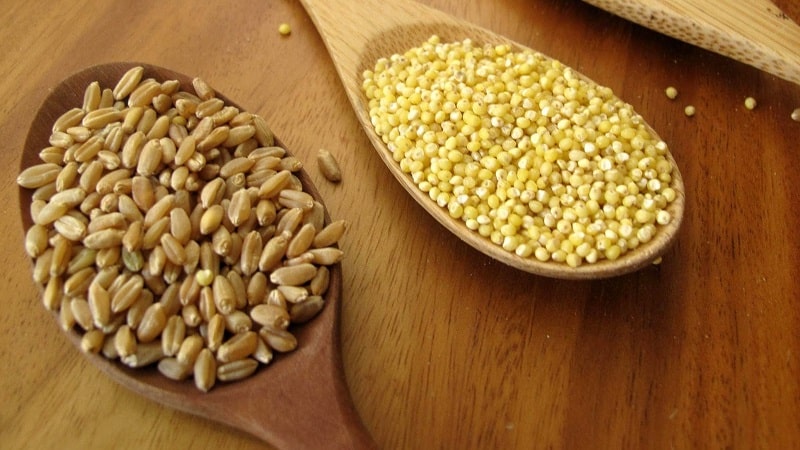
The benefits and harms of millet and wheat
Bulgur and other types Wheat, thanks to its beneficial nutrients, has a positive effect on the following body systems:
- hematopoietic system (vitamin B9, iron);
- blood coagulation system (vitamin K, calcium);
- cardiovascular system (B vitamins, vitamin PP, potassium, magnesium);
- musculoskeletal system (calcium, phosphorus);
- reproductive system (vitamin E);
- nervous system (vitamins B1, B6, choline);
- vision (carotenoids, lutein and zeaxanthin);
- skin, hair, nails, tooth enamel (B vitamins, vitamin E, selenium, phosphorus, calcium).
Among all wheat cereals, semolina and couscous have the greatest benefits for the body., since they are prepared from grains with an unseparated germ part, which contains more vitamins than the endosperm (the central nutritious part of the grain).
Wheat products are not recommended for people with diabetes due to the high glycemic index (45 for whole grains, wheat and bulgur, 50 for durum wheat pasta, 60 for semolina and couscous, 85 for flour).
Millet supports the health of the following body systems:
- endocrine and mixed secretion glands: thyroid gland, adrenal glands, pancreas, sex glands (iodine, copper, manganese, chromium, zinc, cobalt, molybdenum, vitamin E);
- hematopoietic system (vitamin B9, iron);
- cardiovascular system (B vitamins, vitamin PP, potassium, magnesium);
- musculoskeletal system (calcium, phosphorus);
- kidneys (B vitamins, molybdenum);
- reproductive system (vitamin E);
- nervous system (B vitamins);
- skin, hair, nails, tooth enamel (fluorine, sulfur, phosphorus, calcium, vitamin E, B vitamins).
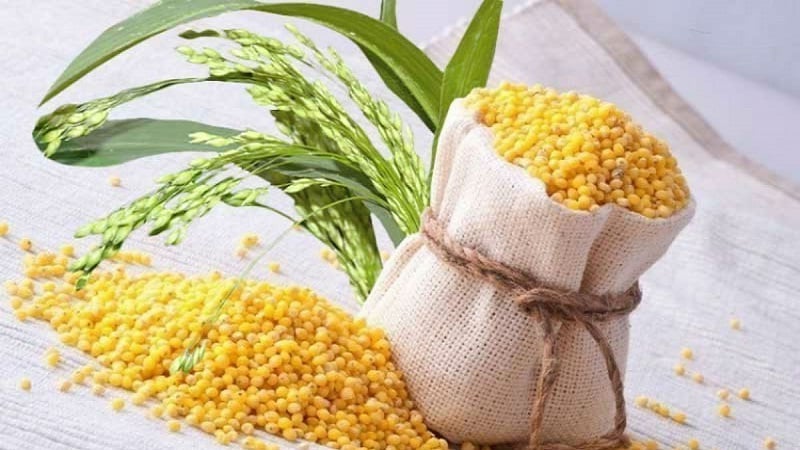
Unlike wheat, millet does not contain gluten., therefore, dishes with millet can be included in the gluten-free diets of patients suffering from celiac disease.
Attention! Before eliminating gluten-containing foods from your diet, consult a dietitian. Excluding foods from your diet without first undergoing blood tests and without medical supervision can lead to metabolic disorders and health problems.
Millet is not recommended for use by people with inflammatory diseases of the digestive tract and dysfunction of the thyroid gland.
Application of millet and wheat
In addition to cooking, millet and wheat are used in folk medicine for the preparation of preventive and medicinal products.
Medicinal properties of millet
Millet is used for weight loss. A number of millet diets have been developed for patients with metabolic disorders. A nutritionist will help you choose the type of millet diet and balance the diet based on biochemical tests that allow you to assess the condition of the body.
Millet porridge supports kidney function and alleviates the condition of cystitis and urolithiasis. It is recommended to use millet for preventive purposes for people living in regions where tap water has high hardness and a low degree of purification.
Magnesium and potassium in millet help people with high blood pressure. Normalizing the functions of the excretory system also has a beneficial effect on blood vessels and helps in reducing blood pressure.
Millet infusion is used for therapeutic and prophylactic purposes., decoction and porridge of sprouted millet.
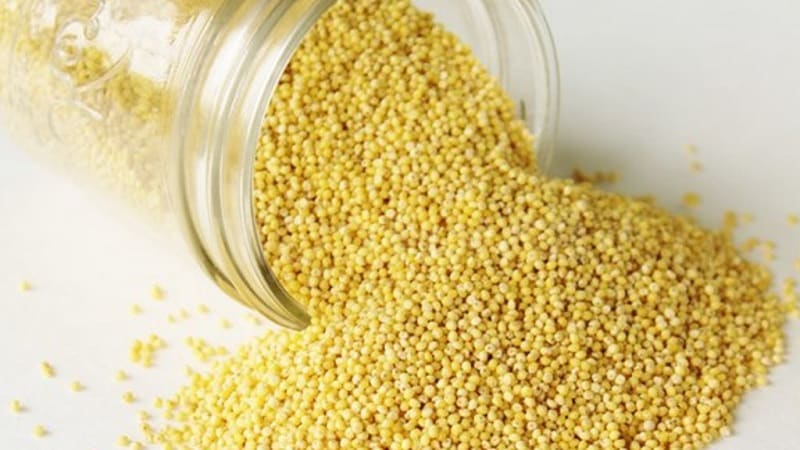
Millet infusion for kidney inflammation
Millet (250 g) is washed with warm water and poured 3 liters of hot water. Cover the jar and leave at room temperature for 24 hours. The liquid is drained through cheesecloth and drunk within 2 days (the infusion cannot be stored for more than two days in the refrigerator). Taking the infusion can last from one week. The millet remaining after infusion is used to prepare porridge or other dishes.
Millet decoction with medicinal herbs for cystitis
Millet (2 tablespoons) is washed with warm water and poured 500 ml of boiling water. After an hour, add 1 tbsp to the millet. l. lingonberry or bearberry leaves. The broth is placed on the fire and brought to a boil with constant stirring. The liquid is filtered through cheesecloth, cooled to room temperature and apply according to the scheme:
- On the first day - 1 tbsp. l. each hour.
- On the second day - 3 tbsp. l. each hour.
- On days 3-7 – half a glass 3 times a day before meals.
The course lasts a week. If necessary, after a five-day break, the course is repeated.
Sprouted millet porridge with cranberries to cleanse the kidneys and reduce blood pressure
Millet, which is sold in stores, is not suitable for this recipe, since polished grain does not have an embryonic part.

Unthreshed millet is used for germination:
- The millet is washed and placed in a container. Fill with clean drinking water so that the grains are lightly covered with water. Cover the container with damp gauze and leave in a warm place for 2-4 days until sprouts appear.
- The sprouted grains are washed, cleared of the millet husk, it is opened and separated from the grains during germination and floats in the water. The finished grains are dried.
- A glass of sprouted millet is poured with two glasses of water, half a glass of dried cranberries, butter and sugar are added to taste. Cook over low heat, stirring occasionally, for 7-10 minutes.
- Cover the pan with a lid and leave at minimum heating temperature for 25-30 minutes.
This porridge will be a tasty and healthy breakfast.
Medicinal properties of wheat
In traditional medicine wheat germ extract is used as an immunomodulator and treatment agent burns, ulcers and wounds. Wheat starch is an auxiliary component of powders, ointments and enemas.
In folk medicine A decoction is made from wheat and used as a general tonic. after suffering injuries and illnesses. A decoction of wheat bran is used for constipation in enemas. Inside, a wheat decoction with honey and medicinal herbs is used for coughs.
Wheat sprouts have immunostimulating, regenerative, anti-aging properties. They are used raw, milk is made from them and wellness cocktails.
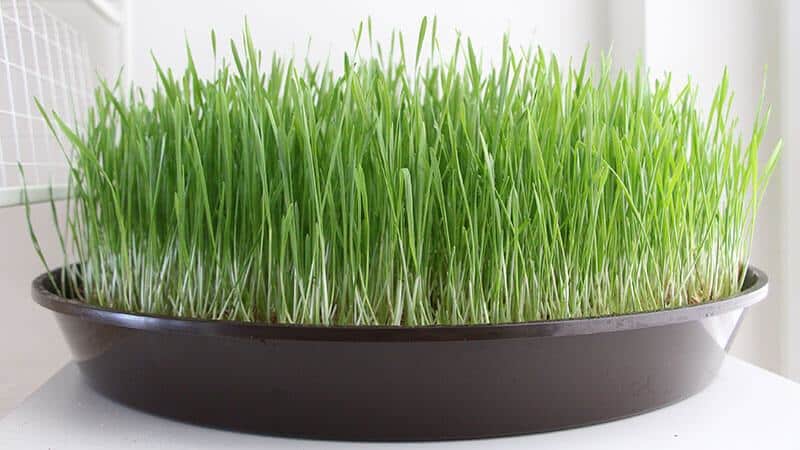
Non-stagnant wheat is used to prepare medicines, which is best purchased immediately after the harvest period. Pay attention to the grain labeling. Grains must undergo quality control in accordance with GOST 9353-2016 “Wheat. Technical conditions".
Wheat, according to this regulatory documentation, is divided into classes based on gluten content, as an indirect indicator of the nutritional value and quality of the grain. Buy premium, first or second grade wheat. Classes 3 to 5 contain fewer proteins and beneficial nutrients - these are grains that are late ripened or grown with a lack of microelements in the soil.
Gruel from ground wheat to improve immunity
Approximately 100 g of grains are washed with running water, soaked for 2-3 hours in a warm, dark place. Then the swollen grains are dried and crushed with a meat grinder or blender. Add 1 tbsp. l.honey and sour cream, cream or milk until the desired consistency is obtained. For a month, the pulp is taken in the morning on an empty stomach. The mixture does not keep for long, so it is better to prepare it in the evening and put it in the refrigerator until the morning.
Wheat bran infusion to stimulate hematopoiesis
Wheat bran (3 tablespoons) is washed with running water, poured with a glass of boiling water and leave under closed lid for 2 hours. The finished infusion is filtered. The liquid is stored in the refrigerator for no longer than three days. Take 1 tbsp infusion. l. 3-4 times a day before meals until the blood condition improves.
Wheat bran decoction for constipation
Bran (200g) is washed with running water, pour 1 liter of boiling water and cook over low heat for 40-60 minutes. The liquid is filtered twice through four layers of gauze and cooled to a temperature of 35-40°C. Half a liter of the resulting decoction is used as an enema. If there are periodic problems with stool, the enema is repeated.
Wheat germ cocktail to lower cholesterol and detoxify the body
Wheat is washed with cold water and placed in a container with water so that a layer of water lightly covered the grains. Cover with a layer of damp gauze and leave in a warm place for germination. The seedlings are watered periodically.

When the green sprouts reach 7-10 cm, the greens are cut with scissors and washed in a colander. Two or three bunches of greens are poured into 1 liter of 1% fat kefir, add onions and garlic to taste. If there are no digestive problems, add broccoli to the cocktail. The resulting mixture is crushed with a blender and drunk throughout the day.
To cleanse the liver, you can prepare a sweet analogue of this cocktail. Instead of onions, garlic and broccoli, add 2-3 handfuls of dried apricots and half a medium raw beet.
Wheat germ milk for the prevention of cancer
The wheat is washed and germinated until the sprouts hatch, but green shoots have not yet appeared. Sprouts (300 g) are poured with 100-150 ml of drinking water and crushed in a blender until smooth. The resulting liquid is filtered through a double layer of gauze and drunk throughout the day. Prevention is carried out every month for a week.
Culinary recipes from millet
Housewives know that millet is a capricious porridge that requires attention. In the pores of the grains, after processing on technical roller equipment, technical oils are adsorbed, giving the millet a bitter taste, which are difficult to wash out with ordinary cold water. To prevent dishes made from this grain from becoming bitter, the grain is washed several times and doused with boiling water before cooking.
Sweet baked porridge
Sweet millet porridge will be an excellent breakfast. It is suitable for baby food. One serving of this porridge contains 559 kcal, it will give you vigor and strength at the beginning of the day.
Ingredients for four servings:
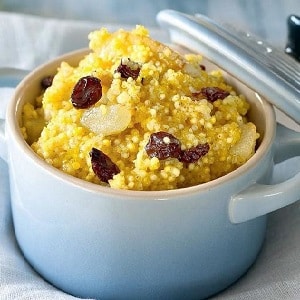 millet – 200 g;
millet – 200 g;- milk – 1 l;
- sugar – 6 tsp;
- raisins – 2 handfuls;
- butter – 2 tbsp. l.;
- ground cinnamon – 2 pinches;
- salt - to taste.
Cooking steps:
- Raisins are washed and soaked in water to swell.
- The cereal is washed and doused with boiling water.
- The washed millet is poured with milk, salt is added, 3 tsp. sugar and cook for 15 minutes.
- The ceramic mold is greased with oil. The oven is preheated to 200°C. The porridge is mixed with raisins and placed in a baking dish. The remaining sugar is mixed with cinnamon and sprinkled on top of the porridge.
- Place the mold in a preheated oven and bake for 15 minutes.
- Pieces of butter are placed on top of the finished porridge.
Classic ear
A fish soup known since childhood, which turns out especially tasty when cooked over a fire.But you can also prepare it at home so that you will lick your fingers. One serving of this traditional first course contains 836 kcal.
Ingredients for four servings:
 fish fillet – 1 kg;
fish fillet – 1 kg;- potatoes – 10 pcs.;
- carrots – 2 pcs.;
- onions – 2 heads;
- millet – 4 handfuls;
- vegetable oil – 100 g;
- salt, spices, herbs - to taste.
Cooking steps:
- The fish fillet is cut into pieces and boiled to create a rich fish broth.
- Vegetables are peeled and cut: onions and carrots into strips, potatoes into cubes.
- The millet is washed and doused with boiling water.
- Remove the fish from the broth and filter the liquid.
- Add vegetables, millet, herbs, salt and spices to the broth and cook over medium heat until the potatoes can be pierced with a knife.
- Then add the boiled fish, add boiling water if necessary to the desired consistency of the soup and cook for another 10 minutes over low heat.
- Cover the finished soup with a lid, cover with a towel and let it brew for another half hour.
Millet porridge with pumpkin in pots
This dish has a neutral taste and is served as a side dish for poultry and dessert, if the portion is flavored with jam or ice cream. One serving of this porridge contains 362 kcal, it is suitable for dietary nutrition for people who want to lose extra pounds.
Ingredients for three servings:
- millet – 100 g;
- pumpkin pulp – 250 g;
- milk – 500 ml;
- sugar - to taste;
- salt - to taste;
- butter – 20 g.
Cooking steps:
- The millet is washed and doused with boiling water.
- The pumpkin pulp is grated on a fine grater.
- 100 g of millet, sugar and salt are poured into an 800-900 ml pot. Add milk, grated pumpkin and mix.
- Place the pot in a cold oven and set the temperature to 150°C. The porridge simmers for about 2 hours.
- Place a piece of butter on top of the finished dish and serve it to the table.
Wheat recipes
Different wheat grains provide a wide range of options for preparing dishes. Bulgur is a grain of Eastern European and Mediterranean origin, couscous is an oriental product, wheat and semolina are used in European cuisine.
Let's look at some of the most delicious and simple recipes that even an inexperienced cook can handle.
Bulgur with vegetables
A simple, healthy and low-calorie side dish that goes well with meat, poultry and white fish dishes. As an independent product, it is suitable for diversifying your diet during Lent. One serving of this side dish contains 278 kcal.
Ingredients for four servings:
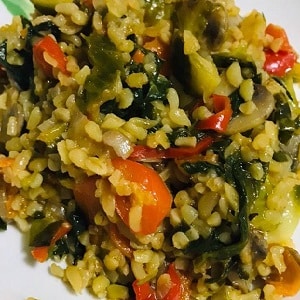 bulgur – 200 g;
bulgur – 200 g;- fresh Brussels sprouts – 600 g;
- red onion – 2 heads;
- pumpkin pulp – 400 g;
- salt, spices - to taste.
Cooking steps:
- The cabbage heads are peeled from the top leaves, cut into two parts lengthwise and fried in vegetable oil on both sides.
- The onion is cut into feathers and sautéed in sunflower oil.
- The pumpkin is cut into cubes and lightly fried with herbs and spices.
- Bulgur is fried in vegetable oil in a large frying pan or casserole until golden brown, poured with water (in the proportion indicated on the package) and cooked until tender.
- Add vegetables to the finished cereal, mix, cover with a lid and let sit for 10-15 minutes.
Pumpkin soup with couscous
Low-calorie soup for dietary nutrition, which can be served as a first course. One serving contains 133 kcal. This healthy dish has a pleasant aroma and exquisite taste.
Ingredients for four servings:
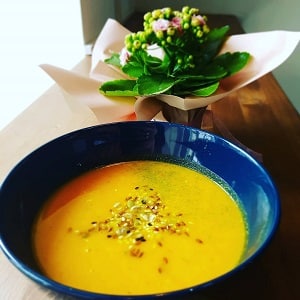 pumpkin pulp – 400 g;
pumpkin pulp – 400 g;- couscous – 5 tbsp. l.;
- ginger root – 20 g;
- onion – 1 head;
- garlic – 1 clove;
- potatoes – 1 pc.;
- vegetable oil – 1.5 tbsp. l.;
- salt, spices - to taste;
- water – 400 ml.
Cooking steps:
- Vegetables are peeled, onions are finely chopped, potatoes and pumpkin are cut into large cubes.
- Place oil in a pan, add onion and chopped garlic and ginger, add spices and fry for 2 minutes with constant stirring.
- Add the pumpkin and potatoes to the pan, add boiling water and cook over medium heat for 20 minutes until tender.
- Cool the dish and grind the mixture with a blender until smooth.
- Couscous is poured with boiling water in a ratio of 1:2, stirred, covered with a lid and left for 5 minutes to swell.
- Pour the cereal into a pan with vegetable puree, mix and leave with the lid closed for another 5 minutes.
Semolina pudding with lemon
A healthy dessert for children and adults. A serving contains only 160 kcal and will help you lose weight in style.
Ingredients for four servings:
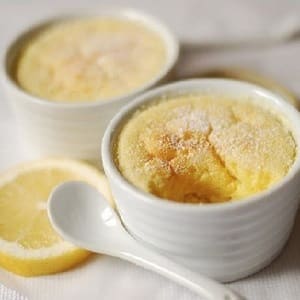 semolina – 22 g;
semolina – 22 g;- milk – 125 ml;
- water – 125 ml;
- sugar – 1.5 tbsp. l.;
- salt – 1 pinch;
- zest of 1 lemon;
- lemon juice – 1.5 tbsp. l.;
- vanilla, cinnamon, nutmeg - to taste.
Cooking steps:
- Mix water with milk and bring the mixture to a boil.
- Carefully pour semolina into boiling water, stirring constantly to prevent lumps from forming.
- Add salt and sugar and cook for 5 minutes while stirring.
- Grate the lemon zest and squeeze out the juice.
- Add lemon juice, spices and zest to the prepared semolina mixture, mix and cool.
- Beat the pudding mixture with a mixer for 5-7 minutes, pour into molds and cool in the refrigerator until completely thickened.
- Before serving, the pudding is decorated with fruits, nuts and whipped cream.
Spelled with mushrooms
A traditional Russian side dish that will give you strength for the whole day. One serving of this dish contains 329 kcal. Spelled porridge goes well with meat dishes, hare and poultry.
Ingredients for four servings:
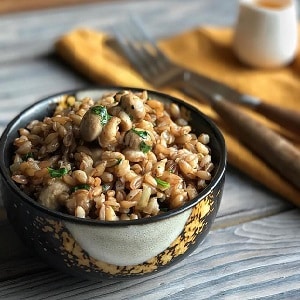 honey mushrooms (you can use fresh champignons) – 200 g;
honey mushrooms (you can use fresh champignons) – 200 g;- onions – 2 heads;
- vegetable oil – 4 tbsp. l.;
- spelled cereal – 150 g;
- salt, spices - to taste.
Cooking steps:
- The mushrooms are washed and chopped.
- The onion is cut into cubes and fried in a pan.
- The spelled is washed and stewed together with onions without water for 5 minutes.
- Mushrooms are fried separately.
- Mushrooms are combined with onions and spelt, poured with water so that it slightly covers the ingredients, salt and spices are added and simmered over low heat under the lid for 40 minutes.
- If necessary, add water if it evaporates too quickly.
- Leave the finished porridge covered for another 10 minutes.
Conclusion
Millet is a ready-made cereal made from processed millet, which is used for making porridges and soups. In folk medicine, millet is used for weight loss, for kidney and bladder diseases, and for reducing blood pressure. Millet grains are round, yellow, 1-2 mm in diameter, have a characteristic taste and smell with notes of mown grass.
Wheat is a cereal crop that is processed into wheat grits, semolina, couscous and bulgur. Wheat grains are golden in color, oval with a characteristic longitudinal groove, 5-7 mm in length. Wheat and its products contain gluten and are contraindicated for people with celiac disease. In addition to the grains themselves, wheat bran and sprouts are used in folk medicine as an immunostimulant, tonic and rejuvenating agent.